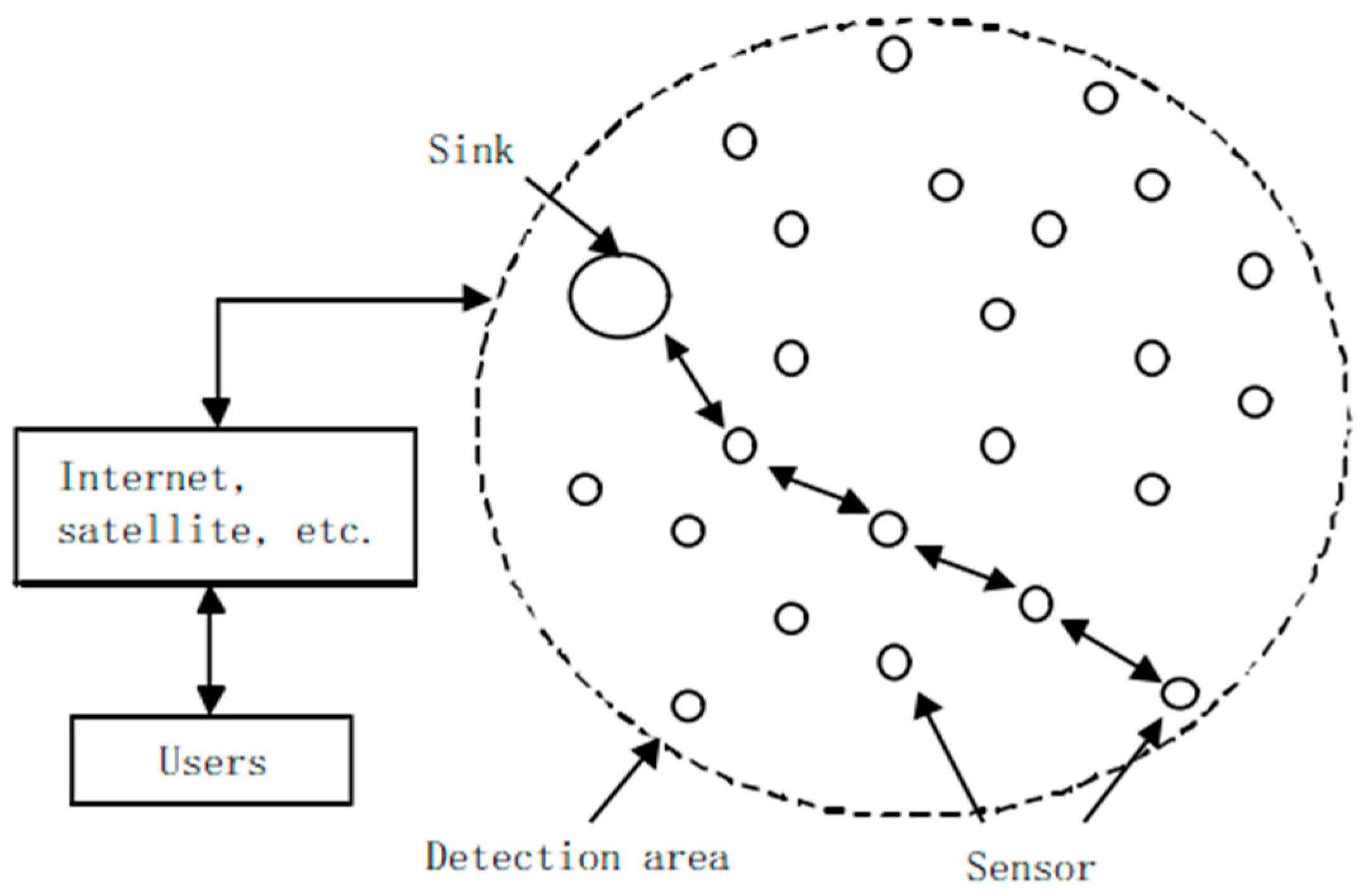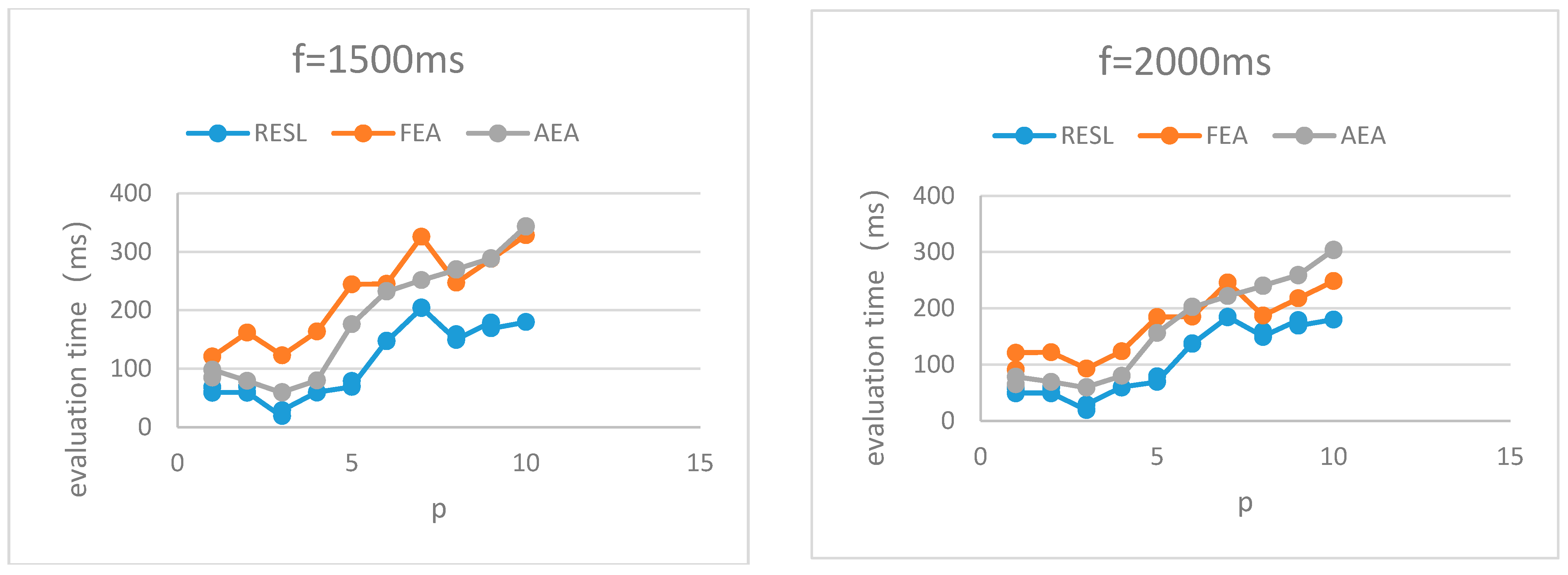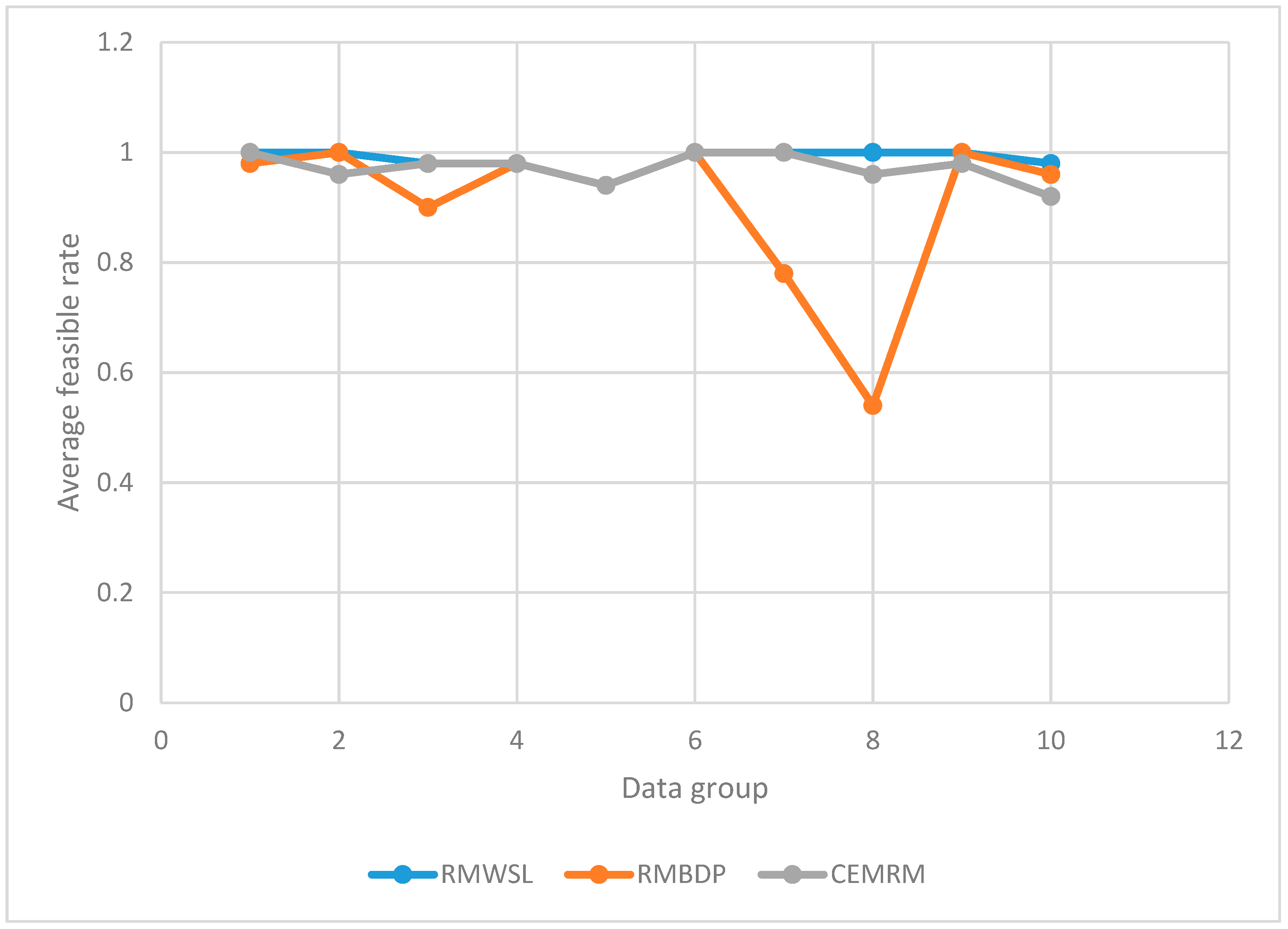Multi-Path Routing Algorithm for Wireless Sensor Network Based on Semi-Supervised Learning
Abstract
1. Introduction
2. Real-Time Evaluation Algorithm Based on Semi-Supervised Learning (RESL)
2.1. Algorithm Design and Implementation
| Algorithm 1: TSVM |
| 1: Input: labeled sample set , |
| 2: unlabeled sample set , |
| 3: parameters and |
| 4: Initialize and , ; |
| 5: Train an initial model SVM0 with ; |
| 6: Predict the label of with SVM0, obtain ; |
| 7: While |
| 8: Knowing , , , and , obtain and according to formula 1; |
| 9: While |
| 10: = −; |
| 11: = −; |
| 12: Knowing , , , and , obtain and according to formula 1; |
| 13: End while |
| 14: ; |
| 15: End while |
| 16: Output: , TSVM = SVMfinal |
| Algorithm 2: Data Enhancement for TSVM |
| 1: Read the training data set according to the number of paths p involved in the routing scheme; |
| 2: Input: labeled sample set , |
| 3: unlabeled sample set , |
| 4: parameters and |
| 5: Initialize and , ; |
| 6: // Expand labeled samples |
| 7: Train an initial model SVM0 with ; |
| 8: Split into and according to the positive or negative of y, and the number of samples are recorded as n+ and n− |
| 9: Perform high-dimensional clustering on the de-labeled sample sets of and ; |
| 10: FOR |
| 11: Randomly select a pair of samples from the largest cluster of ; |
| 12: Generate according to Equation (2); |
| 13: Predict the label of with SVM0, obtain ; |
| 14: IF |
| 15: Merge into ; |
| 16: END IF |
| 17: END FOR |
| 18: FOR |
| 19: Randomly select a pair of samples from the largest cluster of ; |
| 20: Generate according to Equation (2); |
| 21: Predict the label of with SVM0, obtain ; |
| 22: IF |
| 23: Merge into ; |
| 24: END IF |
| 25: END FOR |
| 26: // Expand unlabeled samples |
| 27: Train a model TSVM0 with , , , ; |
| 28: Perform high-dimensional clustering on ; |
| 29: FOR |
| 30: Randomly select a pair of samples from the largest cluster of ; |
| 31: Generate according to Equation (2); |
| 32: END FOR |
| 33: Train a model TSVM1 with , ; |
| 34: FOR |
| 35: Predict the label of with TSVM0 and TSVM1, obtain and ; |
| 36: IF |
| 37: Merge into ; |
| 38: END IF |
| 39: END FOR |
| 40: Output: Expanded and |
| Algorithm 3: Real-time evaluation algorithm based on semi-supervised learning (RESL) |
| 1: Read the training data set according to the number of paths p involved in the routing scheme; |
| 2: Input: labeled sample set , |
| 3: unlabeled sample set , |
| 4: the scheme to be checked |
| 5: IF |
| 6: Determine whether x is abnormal according to Equation (3), obtain y; |
| 7: ELSE |
| 8: IF |
| 9: Perform Algorithm 2; |
| 10: Perform Algorithm 1, obtain TSVM; |
| 11: Predict x with TSVM, obtain y; |
| 12: ELSE |
| 13: Perform Algorithm 1; |
| 14: Predict x with TSVM, obtain y; |
| 15: END IF |
| 16: END IF |
| 17: Output: y |
2.2. Comparative Experiment
- Evaluation accuracy
- 2.
- Evaluation time
3. Multi-Path Routing Algorithm for Wireless Sensor Network Based on
3.1. Semi-Supervised Learning (MRSSL)
3.2. Algorithm Design and Implementation
| Algorithm 4: Multi-path routing algorithm for wireless sensor networks based on semi-supervised learning (MRSSL) |
| 1: Generate the initial multi-path routing scheme x according to the wireless sensor network multi-path routing algorithm proposed in reference [4]; |
| 2: Read the training data set according to the number of paths p involved in the routing scheme; |
| 3: Input: labeled sample set , |
| 4: unlabeled sample set , |
| 5: parameter N |
| 6: FOR n = 1 to N |
| 7: Perform Algotithm 3, obtain y; |
| 8: IF |
| 9: break out; |
| 10: Else |
| 11: make an adjustment to x; |
| 12: END IF |
| 13: END FOR |
| 14: Output: final x |
3.3. Comparative Experiment
4. Conclusions
Author Contributions
Funding
Institutional Review Board Statement
Informed Consent Statement
Data Availability Statement
Conflicts of Interest
References
- Sun, L.M. Wireless Sensor Network; Tsinghua University Press: Beijing, China, 2015. [Google Scholar]
- Moharamkhani, E.; Zadmehr, B.; Memarian, S.; Saber, M.J.; Shokouhifar, M. Multiobjective fuzzy knowledge-based bacterial foraging optimization for congestion control in clustered wireless sensor networks. Int. J. Commun. Syst. 2021, 34, e4949. [Google Scholar] [CrossRef]
- Esmaeili, H.; Hakami, V.; Minaei, B.; Shokouhifar, M. Application-specific clustering in wireless sensor networks using combined fuzzy firefly algorithm and random forest. Exp. Syst. Appl. 2022, 210, 118365. [Google Scholar] [CrossRef]
- Rahul, C.S.; Jan, M.R. Energy Aware Routing for Low Energy Ad Hoc Sensor Networks. In Proceedings of the IEEE Wireless Communications and Networking Conference, Orlando, FL, USA, 17–21 March 2002; Volume 1, pp. 17–21. [Google Scholar]
- Wang, Y.X.; Nie, G.F.; Tian, H. A Graph Routing Algorithm Enhancing Wireless Sensor Networks Lifetime. In Proceedings of the 2021 International Conference on Space-Air-Ground Computing (SAGC), Huizhou, China, 23–25 October 2021. [Google Scholar]
- Addisalem, G.; Lobiyal, D.K.; Jemal, H.A. Energy Efficient Multipath Routing Algorithm for Wireless Multimedia Sensor Network. Sensors 2019, 19, 3642. [Google Scholar] [CrossRef] [PubMed]
- Priti, M.; Kapil, G. Energy balanced, delay aware multi-path routing using particle swarm optimisation in wireless sensor networks. Sens. Netw. 2021, 35, 10–22. [Google Scholar] [CrossRef]
- Messous, S.; Liouane, N. Multi-hop energy-efficient routing protocol based on Minimum Spanning Tree for anisotropic Wireless Sensor Networks. In Proceedings of the 2019 International Conference on Advanced Systems and Emergent Technologies, Hammamet, Tunisia, 19–22 March 2019. [Google Scholar]
- Li, J.; Chang, X.; Ren, Y. An effective path load balancing mechanism based on SDN. In Proceedings of the 13th International Conference on Trust, Security and Privacy in Computing and Communications, Beijing, China, 24–26 September 2014; pp. 527–533. [Google Scholar]
- Lee, K.M.; Teng, W.G.; Hou, T.W. DRASE: A Dynamic Rescheduling and Self-Adaptive Estimation Technique to Enhance ACS Throughputs in CWMP. IEEE Commun. Lett. 2016, 2161–2164. [Google Scholar] [CrossRef]
- Zhou, Z.H. Machine Learning; Tsinghua University Press: Beijing, China, 2018. [Google Scholar]





| The Number of Paths | Evaluation Accuracy | ||
|---|---|---|---|
| RESL | FEA | AEA | |
| p = 1 | 0.98 | 0.94 | 0.96 |
| p = 2 | 0.98 | 0.92 | 0.98 |
| p = 3 | 1 | 0.94 | 1 |
| p = 4 | 1 | 0.92 | 1 |
| p = 5 | 1 | 0.88 | 0.96 |
| p = 6 | 0.98 | 0.88 | 0.94 |
| p = 7 | 0.96 | 0.84 | 0.94 |
| p = 8 | 1 | 0.88 | 0.94 |
| p = 9 | 1 | 0.86 | 0.94 |
| p = 10 | 1 | 0.84 | 0.92 |
| The Number of Paths | Algorithm Running Time (ms) | ||
|---|---|---|---|
| RESL | FEA | AEA | |
| p = 1 | 19, 29, 19, 19, 20 | 1, 1, 1, 1, 1 | 5, 19, 19, 19, 19 |
| p = 2 | 20, 20, 30, 19, 20 | 2, 2, 2, 2, 2 | 40, 40, 40, 40, 40 |
| p = 3 | 19, 29, 29, 29, 29 | 3, 3, 3, 3, 3 | 59, 60, 59, 60, 60 |
| p = 4 | 60, 60, 59, 59, 60 | 4, 4, 4, 4, 4 | 80, 80, 80, 80, 80 |
| p = 5 | 69, 69, 79, 69, 70 | 5, 5, 5, 5, 5 | 100, 100, 100, 100, 100 |
| p = 6 | 110, 109, 109, 109, 109 | 6, 6, 6, 6, 6 | 120, 119, 120, 120, 119 |
| p = 7 | 129, 129, 129, 130, 130 | 7, 7, 7, 7, 7 | 140, 140, 140, 140, 140 |
| p = 8 | 150, 159, 149, 150, 150 | 8, 8, 8, 8, 8 | 159, 160, 160, 160, 160 |
| p = 9 | 179, 169, 169, 169, 169 | 9, 9, 9,9, 9 | 180, 180, 180, 179, 180 |
| p = 10 | 180, 180, 180, 180, 180 | 10, 10, 10, 10, 10 | 200, 200, 199, 199, 200 |
| Data Group | Average Feasible Rate | ||
|---|---|---|---|
| RMWSL | RMBDP | CEMRM | |
| 1 | 1 | 0.98 | 1 |
| 2 | 1 | 1 | 0.96 |
| 3 | 0.98 | 0.90 | 0.98 |
| 4 | 0.98 | 0.98 | 0.98 |
| 5 | 0.94 | 0.94 | 0.94 |
| 6 | 1 | 1 | 1 |
| 7 | 1 | 0.78 | 1 |
| 8 | 1 | 0.54 | 0.96 |
| 9 | 1 | 1 | 0.98 |
| 10 | 0.98 | 0.96 | 0.92 |
Publisher’s Note: MDPI stays neutral with regard to jurisdictional claims in published maps and institutional affiliations. |
© 2022 by the authors. Licensee MDPI, Basel, Switzerland. This article is an open access article distributed under the terms and conditions of the Creative Commons Attribution (CC BY) license (https://creativecommons.org/licenses/by/4.0/).
Share and Cite
Guo, Y.; Hu, G.; Shao, D. Multi-Path Routing Algorithm for Wireless Sensor Network Based on Semi-Supervised Learning. Sensors 2022, 22, 7691. https://doi.org/10.3390/s22197691
Guo Y, Hu G, Shao D. Multi-Path Routing Algorithm for Wireless Sensor Network Based on Semi-Supervised Learning. Sensors. 2022; 22(19):7691. https://doi.org/10.3390/s22197691
Chicago/Turabian StyleGuo, Yiping, Guyu Hu, and Dongsheng Shao. 2022. "Multi-Path Routing Algorithm for Wireless Sensor Network Based on Semi-Supervised Learning" Sensors 22, no. 19: 7691. https://doi.org/10.3390/s22197691
APA StyleGuo, Y., Hu, G., & Shao, D. (2022). Multi-Path Routing Algorithm for Wireless Sensor Network Based on Semi-Supervised Learning. Sensors, 22(19), 7691. https://doi.org/10.3390/s22197691





